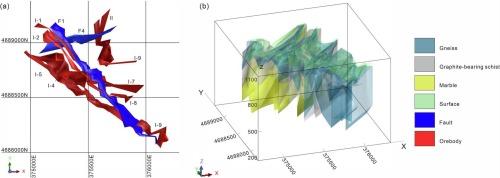Distribution of orebodies and gold grades and their structural controls at the Chaihulanzi gold deposit, NE China: constraints from 3D modeling and fractal analysis
IF 3.6
2区 地球科学
Q1 GEOLOGY
引用次数: 0
Abstract
The multi-scale controls on the spatial distribution of orebodies and gold grades at the Chaihulanzi gold deposit remain enigmatic. The orogenic gold mineralization is hosted by graphite-bearing schists, gneisses, and diorites. Our study employed Surpac 3D modeling technology to define the spatial morphology of orebodies and applied the number–size fractal model to analyze the gold grade distribution, quantitatively characterizing the influence of ore-controlling fault systems. Our 3D model is based on geological profiles, outcrop observations and drill hole data. It reveals that the NW–SE-trending and nearly E–W-trending ore-controlling faults are compatible with a Riedel shear system. The NW–SE-trending transpressional faults controlled continuous, tabular orebodies that extend into deep en-echelon veins, whereas the nearly E–W-trending transtensional faults formed discontinuous, lens-shaped orebodies. Fractal analysis indicates that gold grades in most cross-cuts display a bifractal pattern. The orebodies controlled by transpressional faults with more intense mineralization have higher fractal dimensions (D2: 0.59–5.75; median 1.84) and thresholds (median 3.1 g/t) compared to those controlled by transtensional faults (D2: 0.75–5.25; median 1.4; threshold median 1.03 g/t). This can be explained by the dense and interconnected ore-controlling microfractures in transpressional faults associated with variable gold grade distribution, relative to sparse and dispersed microfractures in transtensional faults associated with uniform gold grade distribution. The gold grades of orebodies are decreasing in wall rocks from graphite-bearing schist to gneiss to diorite porphyry, which, together with a decreasing intensity of quartz-sericite alteration, can be attributed to the influence of fluid–rock reactions. Our study contributes to the better understanding of deposit-scale and micro-scale controls on mineralization and gold grades at the Chaihulanzi deposit with significant implications for optimizing deep and regional exploration strategies.

柴胡兰子金矿床矿体、金品位分布及其构造控制:三维建模和分形分析约束
柴胡兰子金矿床矿体空间分布和金品位的多尺度控制仍然是一个谜。造山带金矿成矿以含石墨片岩、片麻岩和闪长岩为主。利用Surpac三维建模技术定义矿体空间形态,应用数-尺寸分形模型分析金矿品位分布,定量表征控矿断裂系统的影响。我们的3D模型是基于地质剖面、露头观测和钻孔数据。结果表明,北西东向和近东西向控矿断裂与里德尔剪切体系相匹配。北西-东南向的张拉断裂控制了连续的板状矿体,并延伸至深雁列矿脉,而近东西向的张拉断裂则形成了不连续的透镜状矿体。分形分析表明,大部分断面的金品位呈分形分布。断裂控制的矿体分形维数(D2: 0.59 ~ 5.75,中值1.84)和阈值(中值3.1 g/t)均高于断裂控制的矿体(D2: 0.75 ~ 5.25,中值1.4,中值1.03 g/t)。这可以解释为,与金品位均匀分布的张拉断裂微裂缝稀疏分散相比,张拉断裂控矿微裂缝致密且相互连接。从含石墨片岩到片麻岩再到闪长斑岩,围岩中矿体金品位逐渐降低,且石英绢云母蚀变强度逐渐减弱,可归因于流体-岩石反应的影响。该研究有助于更好地认识柴胡兰子金矿床的矿床尺度和微观尺度对成矿和金品位的控制作用,对优化深部和区域找矿策略具有重要意义。
本文章由计算机程序翻译,如有差异,请以英文原文为准。
求助全文
约1分钟内获得全文
求助全文
来源期刊

Ore Geology Reviews
地学-地质学
CiteScore
6.50
自引率
27.30%
发文量
546
审稿时长
22.9 weeks
期刊介绍:
Ore Geology Reviews aims to familiarize all earth scientists with recent advances in a number of interconnected disciplines related to the study of, and search for, ore deposits. The reviews range from brief to longer contributions, but the journal preferentially publishes manuscripts that fill the niche between the commonly shorter journal articles and the comprehensive book coverages, and thus has a special appeal to many authors and readers.
 求助内容:
求助内容: 应助结果提醒方式:
应助结果提醒方式:


